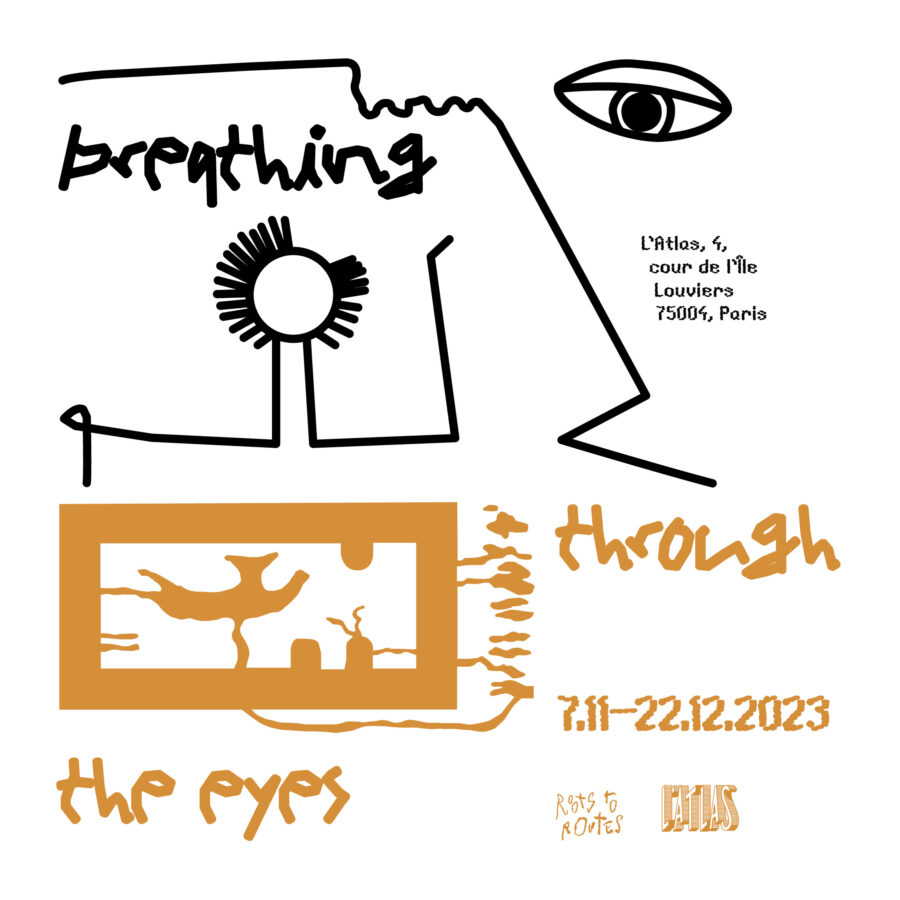
L’Atlas 4 Cour de l’île Louviers, 75004 Paris
Start Date:
07.11.2023
End Date:
03.01.2024
Artists: Aili Vint (EE), Daria Melnikova (LV), Kristel Saan (EE), Kristina Õllek (EE), Monika Varšavskaja (EE/FR), Morta Jonynaitė (LT), Viktorija Daniliauskaitė (LT)
Curator: Merilin Talumaa (EE)
The exhibition Breathing Through the Eyes at L’Atlas in Paris gathers together different generations of artists from the Baltic countries, most of them presenting their work in Paris for the first time.
The exhibition touches subtly on the ideas of Lithuanian-American archaeologist and anthropologist Marija Gimbutas, whose profound research brought attention to the ancient cultures of the Baltic region and the broader Indo-European world, especially well described in her book The Balts (1963). The exhibition takes its inspiration from Gimbutas’ ideas which have influenced contemporary perspectives on heritage, indigenous identities, and the relationship between humans and nature in the Baltic Sea area.
Research on the cross-disciplines of archaeological artefacts, linguistics, ethnography and folklore led Gimbutas to posit the thesis that prehistoric European culture was female-centred and worshipped a Mother Goddess as the giver of all life. The Goddess’ power was in water and stone, in cave and tomb, in animals and birds, in hills, trees and flowers. A spiritual sense of connectedness was artfully expressed through a sophisticated symbol system and an abundance of ritual objects. Nature and body (especially the female body) were honoured in Europe for tens of thousands of years. Women had an especially strong position in societies across Eastern and Central Europe – a tendency no longer necessarily evident today.
The exhibition Breathing through the eyes poetically comments on the fragile materiality of our being, multiple identities, the process of change and new environmental sensibility. Gimbutas, who having opened the treasure trove of prehistory, inspired a belief in a peaceful existence in our time – to bring back to life suppressed vital elements, such as the earth, the body (health), the feminine, and the subconscious. Participating artists, through imaginative and fictitious narratives, share personal stories and beliefs that also reflect the influence of Gimbutas’ theories on ancient symbolism. Their works echo these concepts through a contemporary lens, incorporating elements such as spirals, circles, and motifs such as snakes and birds – symbols rooted in ancient European matriarchal cultures that continue to resonate in Baltic art and culture.
The exhibition directs us to consider how we might reimagine a world centred around goddess worship, with its emphasis on preserving nature, nurturing existence, and forsaking warfare. Could this theoretical concept transcend into the tangible reality of our future society? Breathing through the eyes seamlessly intertwines historical narratives, cultural myths, and potential scenarios, immersing us in the themes that Marija Gimbutas ignited: the celebration of life’s cycles, the sanctity of the female body and labour, and the spirituality inherent in these concepts. Gimbutas’ exploration of the spiritual dimensions of a harmonious Old Europe and her vision for a New Europe free from dominance and warfare feels remarkably pertinent in our contemporary world.
Gastronomic performance: Monika Varšavskaja (EE/FR)
Exhibition setup: Daria Melnikova (LV)
Communication visuals: Gaile Pranckunaite (LT)
Exhibition stays open until December 22, 2023.
L’Atlas
4 Cour de l’île Louviers, 75004 Paris
Opening hours: Tuesday—Saturday, 12pm—7pm
Free entrance
Marija Gimbutas (1921–1994) was a Lithuanian-American archaeologist and anthropologist. She contributed to what is considered to be one of the most significant academic watershed moments in women’s studies with her archaeological and philosophical work on Neolithic culture and religion. Gimbutas is best known for her research into the Neolithic and Bronze Age cultures of “Old Europe,” a term she introduced. Old Europe referred to both the geographical area and social structures that existed before the Indo-European influence. Gimbutas unequivocally established the existence of a Goddess religion who is the most persistent feature in the archaeological record of the ancient world. The Goddess in all her manifestations was a symbol of the unity of all life in nature. Gimbutas’ discoveries took on great symbolic importance for feminists across various disciplines who found, in her vision of a peaceful, nature-revering society, a sense of hope for the future based on this foundation in the distant past.
